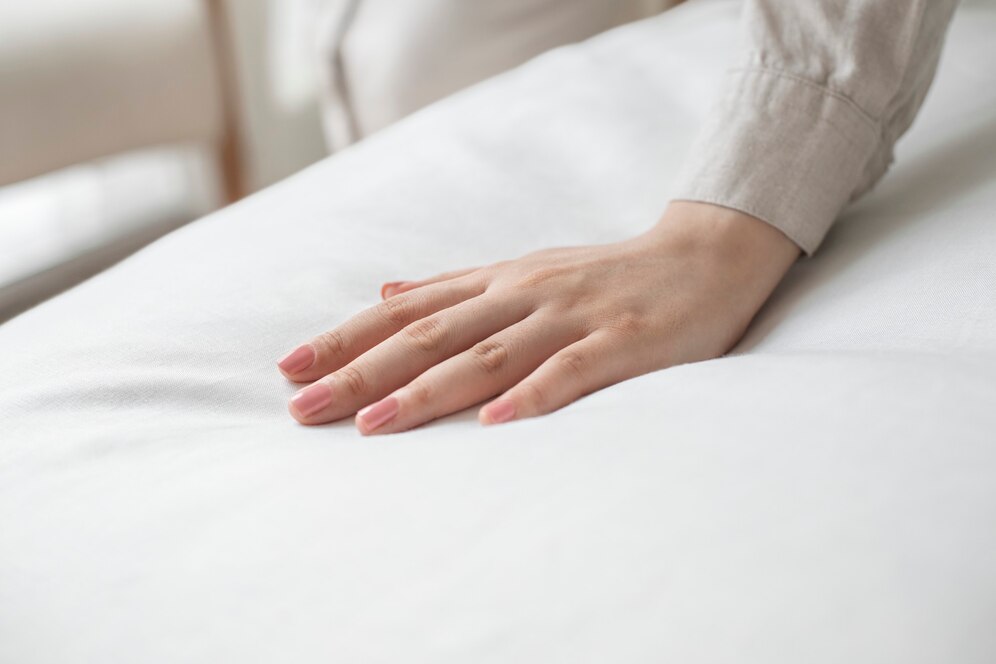
How to Choose the Perfect Mattress for a Good Night’s Sleep
A good night’s sleep is essential for overall well-being, and the right mattress plays a crucial role in ensuring sleep quality. With so many options available, from memory foam vs. spring mattresses to hybrid designs, selecting the best one can feel overwhelming. If you’re looking for the best mattresses in 2025, this guide will help you navigate your choices and find the perfect fit for your needs.
In this article, we’ll explore different mattress types, key factors to consider when buying a mattress, and expert tips on sleep quality improvement through better bedding choices.
Understanding Different Mattress Types

1. Memory Foam Mattresses
Memory foam mattresses are popular for their ability to conform to the body’s shape, providing excellent pressure relief and support.
Benefits:
- Contours to your body, reducing pressure points and enhancing spinal alignment.
- Ideal for side sleepers as it cushions shoulders and hips, preventing discomfort.
- Absorbs motion, making it great for couples who share a bed.
- Available in different firmness levels to accommodate various sleep preferences.
Potential Downsides:
- Can retain heat, although modern models often include cooling gel or open-cell foam to improve airflow.
- Some sleepers find it too soft, especially those who need extra lumbar support.
- A slight chemical odour (off-gassing) may be present when new, though it dissipates over time.
2. Innerspring Mattresses
Spring mattresses, also known as innerspring mattresses, feature a coil-based support system that provides a traditional, bouncy feel.
Benefits:
- Offers firm support, making it ideal for back and stomach sleepers.
- Provides good airflow, keeping the mattress cooler than foam alternatives.
- Often more affordable than memory foam or hybrid options.
- Available in various coil configurations, such as pocketed coils for better motion isolation.
Potential Downsides:
- May not contour as well as foam, leading to pressure points, especially for side sleepers.
- Can be noisy over time if the coils aren’t well encased.
- Tends to have a shorter lifespan compared to foam or latex mattresses.
3. Hybrid Mattresses
A hybrid mattress combines the best features of memory foam and innerspring mattresses, offering both support and comfort.
Benefits:
- Provides excellent balance between support and cushioning, making it suitable for all sleep positions.
- Reduces motion transfer while maintaining breathability.
- Offers a responsive yet contouring feel, making it a great choice for combination sleepers.
- Advanced models include targeted support zones for better spinal alignment.
Potential Downsides:
- Can be more expensive than traditional memory foam or spring mattresses.
- Heavier than other mattress types, making it difficult to move or rotate.
- Some models may still retain heat, depending on the foam layers used.
4. Latex Mattresses
Latex mattresses use natural or synthetic latex for a supportive yet bouncy feel, offering an eco-friendly option for sleepers.
Benefits:
- Highly durable and long-lasting, often outlasting memory foam and innerspring mattresses.
- Naturally hypoallergenic and resistant to dust mites, mould, and mildew.
- Provides good airflow, making it ideal for hot sleepers.
- Offers a responsive feel without excessive sinking.
Potential Downsides:
- Often pricier than memory foam or spring mattresses.
- Can feel too firm for some sleepers, though softer options are available.
- Natural latex mattresses may have a slight rubbery odour when new.
Quick Guide
Mattress Shopping Made Simple
- Sleep Style Matters: Side sleepers need softness; back and stomach sleepers need firmer support.
- Know Your Types: Memory foam = contouring comfort. Innerspring = firm & cool. Hybrid = best of both.
- Body Weight Counts: Heavier sleepers need firmer mattresses to avoid sinking.
- Stay Cool: Look for gel-infused foam, breathable covers, or coil-based designs.
- Longevity Check: Latex and hybrid models often outlast basic spring or foam beds.
Pro Tip
Don’t rely on firmness labels alone—what’s “medium-firm” for one brand may feel entirely different in another. Always try before you buy, or choose a mattress with a generous at-home trial period.
Important
Your mattress directly affects your spinal alignment, pressure relief, and overall sleep quality. The wrong choice can lead to aches, interrupted sleep, or long-term discomfort—so take the time to find a mattress that truly fits your body and lifestyle.
Factors to Consider When Choosing a Mattress

1. Sleeping Position and Mattress Firmness
Your sleep position greatly influences the type of mattress that will provide the best comfort and support.
- Side Sleepers: Medium-soft to medium-firm mattresses offer pressure relief for the shoulders and hips.
- Back Sleepers: Medium-firm to firm mattresses provide spinal alignment and prevent lower back pain.
- Stomach Sleepers: Firm mattresses prevent the lower back from sinking too much, reducing strain on the spine.
- Combination Sleepers: A hybrid mattress with balanced support works well for those who shift positions frequently.
2. Body Weight and Support Needs
- Light Sleepers (under 60kg): Softer mattresses provide better contouring without excessive sinking.
- Average Sleepers (60-100kg): Medium-firm options balance comfort and support for most sleepers.
- Heavy Sleepers (100kg+): Firmer mattresses prevent excessive sinking and offer durability to support body weight evenly.
3. Cooling and Temperature Regulation
If you tend to sleep hot, consider:
- Gel-infused memory foam for heat dissipation.
- Breathable latex or hybrid designs that allow better airflow.
- Moisture-wicking mattress covers for enhanced cooling and sweat absorption.
- Innerspring or hybrid mattresses with coil systems that improve air circulation.
4. Motion Isolation for Couples
For shared beds, memory foam and hybrid mattresses are excellent at reducing motion transfer, preventing sleep disturbances from a restless partner.
5. Durability and Longevity
- Memory foam mattresses last around 7-10 years, depending on quality.
- Innerspring mattresses typically last 5-7 years but may wear out faster if used frequently.
- Hybrid and latex mattresses can last over 10 years with proper care, making them a long-term investment.
Tips for Sleep Quality Improvement
1. Pair Your Mattress with the Right Bedding
- Use a supportive pillow that matches your sleep position for proper neck alignment.
- Opt for breathable bed linens like cotton or bamboo to improve air circulation.
- Add a mattress topper for extra comfort, especially if your mattress is too firm.
- Choose a weighted blanket if you experience anxiety or restless sleep.
2. Maintain Your Mattress
- Rotate it every 3-6 months to prevent uneven wear and indentations.
- Use a mattress protector to shield against dust, spills, and allergens.
- Air out the mattress regularly to keep it fresh and odour-free.
- Avoid sitting on the mattress edges frequently to prevent sagging.
3. Create a Sleep-Friendly Environment
- Keep the bedroom cool (16-18°C is ideal for restful sleep).
- Reduce screen time before bed to limit blue light exposure that disrupts melatonin production.
- Follow a consistent sleep schedule to regulate your body clock and improve sleep cycles.
- Incorporate white noise machines or blackout curtains if you are sensitive to light and noise.
Top 5 FAQs
1. What type of mattress is best for back pain?
Memory foam or hybrid mattresses with medium-firm support are ideal. They cushion pressure points while supporting proper spinal alignment.
2. How often should I replace my mattress?
Typically every 7–10 years, depending on material and use. Latex and hybrid mattresses often last longer than innerspring models.
3. Are memory foam mattresses too hot to sleep on?
Some are—but modern designs often feature cooling gel, open-cell foam, or breathable covers to reduce heat retention.
4. What firmness is best for side sleepers?
Soft to medium-firm mattresses provide pressure relief for the shoulders and hips, making them the most comfortable for side sleepers.
5. Can I test a mattress before committing?
Yes—many brands offer at-home trial periods ranging from 30 to 100 nights. Always check the return policy before purchasing.
Finding the Best Mattress for Your Needs

Choosing the right mattress is essential for achieving quality sleep and overall well-being. Whether you prefer the contouring support of memory foam, the breathability of spring mattresses, or the versatility of hybrids, the key is to match your mattress to your sleep preferences and body needs.
When shopping for the best mattresses in 2025, take your time to test different options, read customer reviews, and consider trial periods offered by manufacturers. Investing in the right mattress today means better sleep, improved health, and greater daily energy.
Which mattress type do you prefer? Share your thoughts in the comments below!